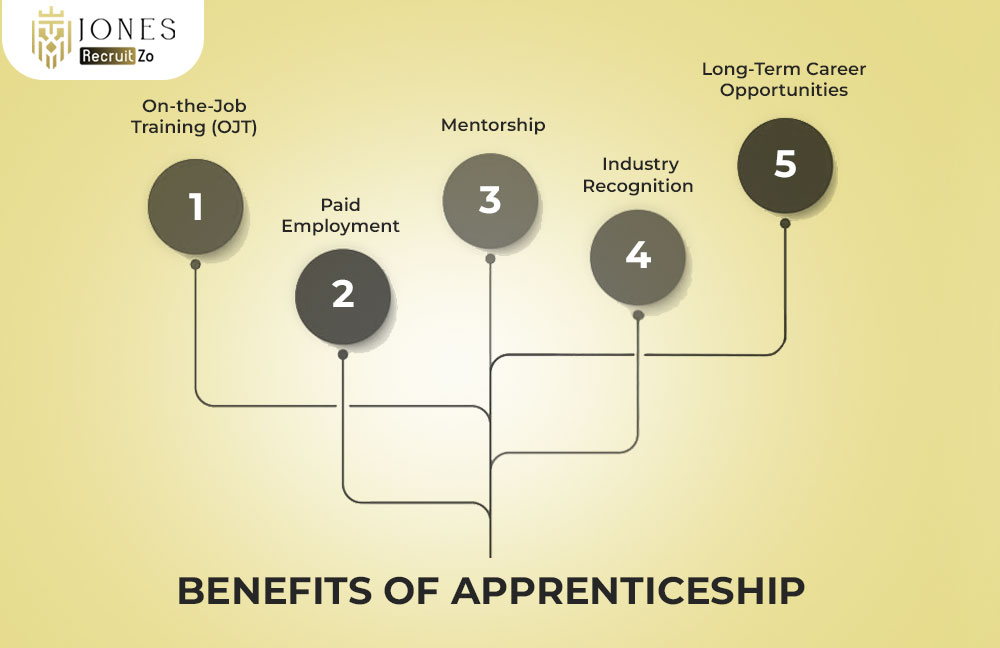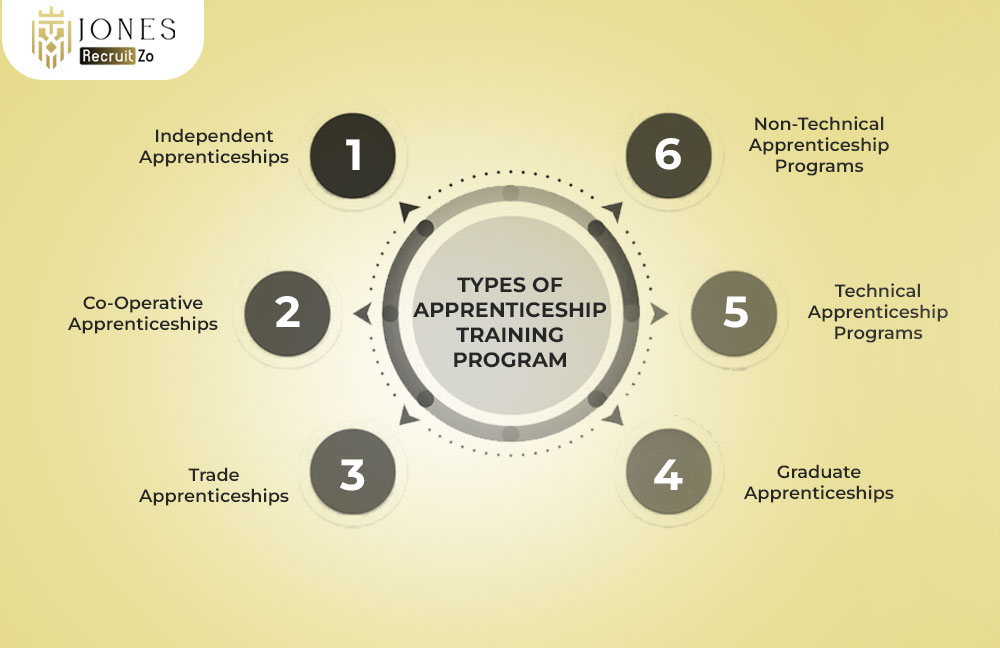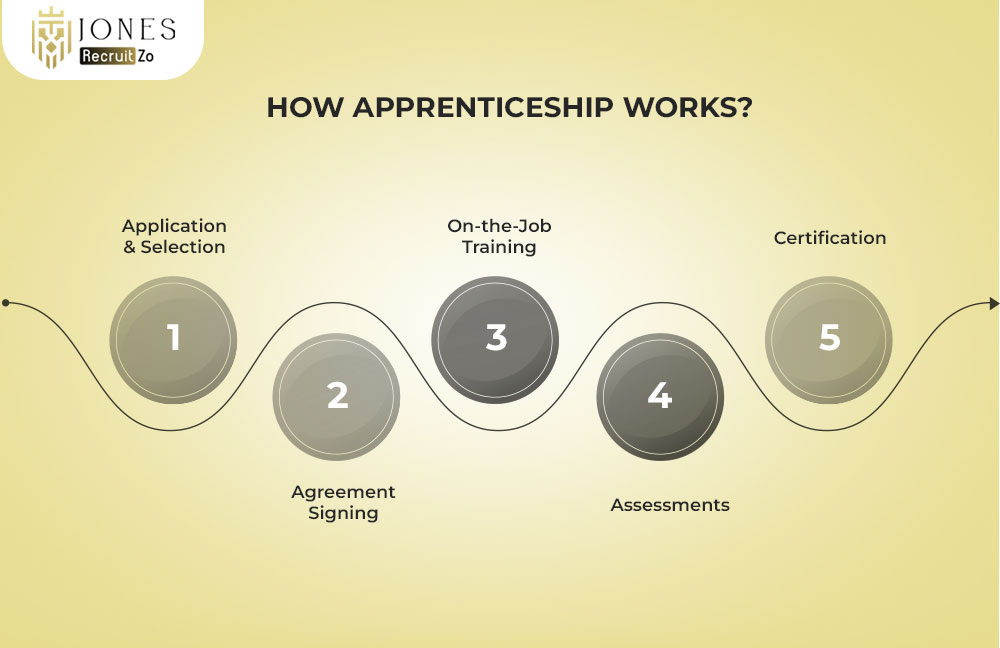What is An Apprenticeship?
An apprenticeship is a training program where individuals learn a trade or skilled job by working with and learning from experienced professionals. Unlike regular schooling, apprenticeships combine classroom instruction with hands-on work experience, and apprentices are paid while they learn.
Benefits of Apprenticeship

The benefits of apprenticeships include hands-on job training, paid work, mentorship, and industry recognition. Apprentices build their skills by learning in class and working at the same time in their trade profession.
-
On-the-Job Training (OJT)
Getting on-the-job training is a main feature of apprenticeship, helping the trainee practice and hone skills used at work. This type of job training raises productivity for those who hire apprentices and provides those apprentices with real-life work experience important for their future in their trade.
-
Paid Employment
One of the major benefits of apprenticeship is that students get paid to learn. Those training as apprentices can earn at the same time, not taking on student loan debt. So, anyone starting out in a skilled trade career or looking to make a career change can see that apprenticeship training is an affordable and interesting way to learn.
-
Mentorship
Mentorship is central to what is an apprenticeship, offering guidance and knowledge from experienced experts. Because of this Employee relationship, apprentices develop soft skills, confidence and build their network. This, in addition to their training, helps them do well in their chosen profession.
-
Industry Recognition
Apprenticeships help people get recognized in their industry for having the skills required by the profession. With recognition from an apprenticeship and a certification, these skilled workers are more likely to get work in the field they chose.
-
Long-Term Career Opportunities
Entering an apprenticeship can help you build a foundation for work and career advancement. Great careers and promotions become possible for individuals interested in apprenticeships when they take advantage of learning both at the job site and in the classroom.
Types of Apprenticeship Training Program

The types of apprenticeship training program are independent, co-operative, trade, graduate, technical and non-technical types of apprenticeship programs. Job training, class schooling and real work experience form part of all apprenticeships which guide people toward skills in different professions.
-
Independent Apprenticeships
Independent apprenticeships are created by employers and concentrate only on training workers for jobs. These emphasize real-world application and paid work, making them ideal for those seeking direct entry into a trade profession through practical work experience.
-
Co-Operative Apprenticeships
A co-operative apprenticeship combines practical work experience with lessons in the classroom. Educators and employers team up to blend theory and actual work training so that apprentices are well prepared with the essential skills needed in today’s trade professions.
-
Trade Apprenticeships
Apprenticeships in trade programs focus on getting training in specific areas such as plumbing, welding or electrical work. In these programs, students get classroom instructions as well as hands-on experience and they earn money while receiving vital training for their career goals in known fields.
-
Graduate Apprenticeships
During graduate apprenticeships, people can acquire job skills while attending classes for a degree and gain practical work knowledge. They let students gain skills needed at work while also teaching them academic subjects, using real trade jobs as part of their training.
-
Technical Apprenticeship Programs
Technical apprenticeship programs offer instruction in a classroom and also provide real-life job training for engineering and IT. With this method, you both learn concepts and do hands-on work, so you are prepared for the attention and new ideas needed in trade professions.
-
Non-Technical Apprenticeship Programs
The focus of non-technical apprenticeships is providing training for work in business, sales or marketing sectors. Combining their soft skills and being paid, they assist apprentices in finding jobs outside engineering by providing classroom support and opportunities for real corporate experience.
How Apprenticeship Works?

An apprentice must go through application, sign an agreement, participate in job training, get evaluated and get certified to go through a successful apprenticeship. Learners take part in paid work, receive guidance from experienced teachers and attend classes to build job and career skills in a trade profession.
-
Application & Selection
It all begins by looking into different programs and checking if you qualify. The next step after filling in applications is taking tests or interviews, with contract signing following. Being taught in steps helps all apprentices get ready for what happens in the classroom as well as what their job role involves.
-
Agreement Signing
The agreement made by the apprentice and employer specifies how training will be given, what the apprentice will earn and the duties for both parties. The contract helps by giving a clear framework for apprenticeship training, managing the match between learning and working requirements.
-
On-the-Job Training
Apprentices learn most of their trade by being trained directly on the job by experienced professionals. Doing practical work along with paid work enhances important abilities and goes well with the training you get at school.
-
Assessments
Assessments, done as part of training or at the end, check the apprentice’s growth and learning at work. They may consist of hands-on tests, writing assignments and meetings with professionals so every apprentice can learn and remember their trade skills.
-
Certification
With certification, an apprentice demonstrates that they have acquired the needed skills and finished their training. Lucrative workplaces are available because the certification offers proof of industry-approved skills and proven work experience.
FAQs
1) What is an apprenticeship?
An apprenticeship is a training program where individuals learn a trade or skilled job by working with and learning from experienced professionals. Unlike regular schooling, apprenticeships combine classroom instruction with hands-on work experience, and apprentices are paid while they learn.
2) What is Apprenticeship Training?
Apprenticeship training gives people hands-on learning in a job, along with formal instruction, helping them acquire skills in their trade profession. It makes work experience better by offering mentorship and hands-on experience.
3) What are the Benefits of Apprenticeship?
The benefits of apprenticeships include hands-on job training, paid work, mentorship, and industry recognition. Apprentices build their skills by learning in class and working at the same time in their trade profession.
4) How does an apprenticeship work?
An apprentice must go through application, sign an agreement, participate in job training, get evaluated and get certified to go through a successful apprenticeship. Learners take part in paid work, receive guidance from experienced teachers and attend classes to build job and career skills in a trade profession.















